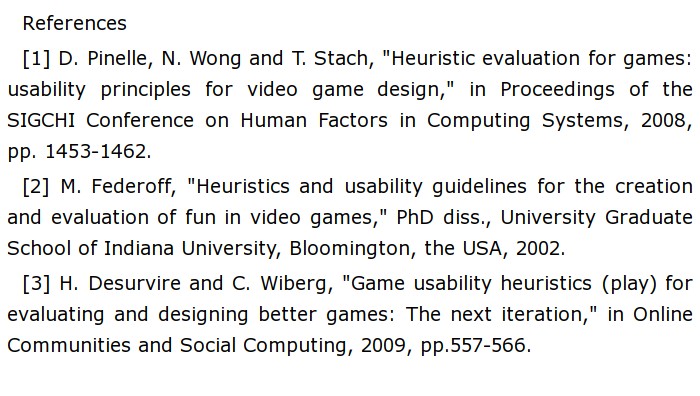|
Usability principles for video game design (literature review) (Сочинения ЕГЭ английский язык)Video games demand constant dialogue with a user so game designers must pay careful attention to usability issues. Neglecting these issues has an adverse effect on the general quality and success of a game. Game usability is interpreted as the extent to which a player is able to learn, control, and understand a game. It does not appeal artistic and technical issues like game plot, music, graphics and audio quality, performance costs, etc [1]. However, some researchers make this concept broader and include the degree of satisfaction of users from the game, i.e. some elements of artistic issues, for example, the exciting storyline of the game [2]. Although usability issues in games are still poorly covered, there are already several special sets of design principles for games. Federoff's game design principles are one of the early research findings and many modern authors of scientific papers, including those who are mentioned below, refer to it in their publications [2]. Melissa Federoff is one of those who interpret the concept of usability extensively. She adds to the classic understanding of usability the degree of fun during the game. Because of this, some of her principles seem blurry, unnecessary and unsuitable for evaluation. For example, the answer to the item "is there a great storyline?" is always subjective, and the statement "the game should have an unexpected outcome" applies only to certain genres. David Pinelle et al. then studied this question [1]. Their heuristics is based on a classical understanding of software usability and is the most successful, as it covers all the real problems of research subject and is suitable for games of all genres. During development this set of principles, researchers first analyzed the games for the presence of problems in them, next grouped similar usability problems and then identified the particular principles of game design based on the groups obtained. One of the latest developments is the PLAY heuristics created by Heather Desurvire and colleagues [3]. Her principles of game development are divided into several categories and one of them concerns usability. This work does not introduce any new game usability principles, only highlights some of the postulates described by Federoff. The main principles of usability mentioned in all the considered works [1], [2] - [3] are the following statements: • players should be supplied with interactive training to teach basics, furthermore, extra help should be available within the application; • users require always be able to identify their game status and be equipped with enough data which are essential for decision making during the game; • control keys should be customizable and default to industry standards (input conventions that are common in other similar games), controls need be easy to manage, intuitive and mapped in a natural way (for example, leveraging spatial relationships: the up button is above the down button, etc.); • the game should provide consistent and immediate responses to the user’s actions; • screen layout must provide visual representations (icons) that are easy to interpret and understand their functions and keep balance the breadth and depth of the interface. Also, significant usability principles can be called skipping non-playable and frequently repeated content and ability to customize game settings (video and audio parameters, difficulty and speed of the game) [1]. Moreover, error prevention is important to take into account. The application should offer saving and recovery of the game [2] - [3]. Useful but optional tip to improve usability in games is the use of colour and sound for taking emphasis, message passing by the user. Unlike playtesting, evaluations games by considered heuristics of usability do not need user participation, so they can be carried out with early mockups as well as with functional prototypes. Also, several studies prove that one of the benefits of using heuristic evaluation is that it helps designers find important classes of problems that are not always recognised with user testing [1].  Обновлено: Опубликовал(а): Фокина Виктория Внимание! Спасибо за внимание.
|
|


